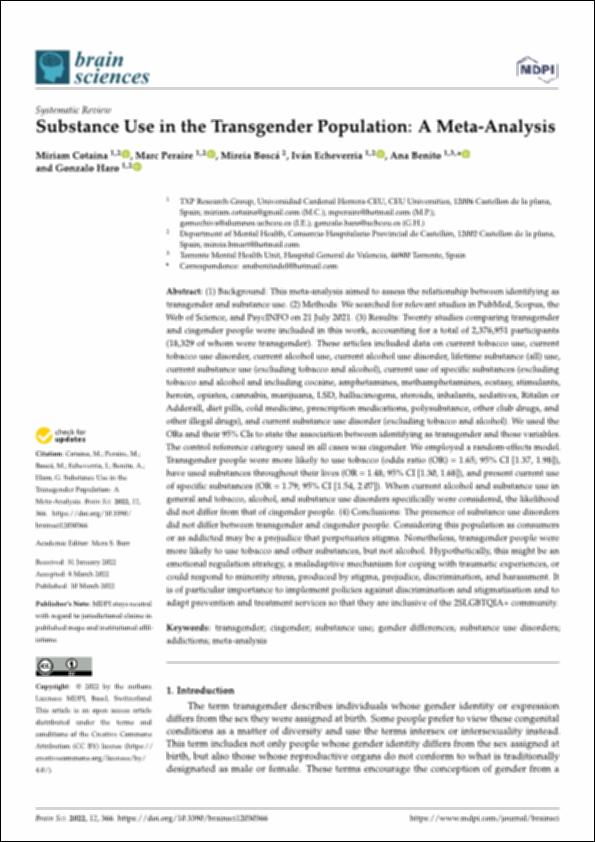Por favor, use este identificador para citar o enlazar este ítem:
http://hdl.handle.net/10637/14221Substance use in the transgender population a meta-analysis
| Título : | Substance use in the transgender population a meta-analysis |
| Autor : | Cotaina Bertó, Miriam Peraire Miralles, Marc Boscá, Mireia Echeverría Gómez, Iván Benito Delegido, Ana Haro Cortés, Gonzalo Rafael |
| Materias: | Diferencias sexuales (Psicología); Sex differences (Psychology); Transsexualism.; Compulsive behavior.; Transexualismo.; Adicciones. |
| Editorial : | MDPI |
| Citación : | Cotaina, M., Peraire, M., Boscá, M., Echeverria, I., Benito, A. & Haro, G. (2022). Substance use in the transgender population: a meta-analysis. Brain Sciences, vol. 12, i. 3 (10 mar.), art. 366. DOI: https://doi.org/10.3390/brainsci12030366 |
| Resumen : | (1) Background: This meta-analysis aimed to assess the relationship between identifying as transgender and substance use. (2) Methods: We searched for relevant studies in PubMed, Scopus, the Web of Science, and PsycINFO on 21 July 2021. (3) Results: Twenty studies comparing transgender and cisgender people were included in this work, accounting for a total of 2,376,951 participants (18,329 of whom were transgender). These articles included data on current tobacco use, current tobacco use disorder, current alcohol use, current alcohol use disorder, lifetime substance (all) use, current substance use (excluding tobacco and alcohol), current use of specific substances (excluding tobacco and alcohol and including cocaine, amphetamines, methamphetamines, ecstasy, stimulants, heroin, opiates, cannabis, marijuana, LSD, hallucinogens, steroids, inhalants, sedatives, Ritalin or Adderall, diet pills, cold medicine, prescription medications, polysubstance, other club drugs, and other illegal drugs), and current substance use disorder (excluding tobacco and alcohol). We used the ORs and their 95% CIs to state the association between identifying as transgender and those variables. The control reference category used in all cases was cisgender. We employed a random-effects model. Transgender people were more likely to use tobacco (odds ratio (OR) = 1.65; 95% CI [1.37, 1.98]), have used substances throughout their lives (OR = 1.48; 95% CI [1.30, 1.68]), and present current use of specific substances (OR = 1.79; 95% CI [1.54, 2.07]). When current alcohol and substance use in general and tobacco, alcohol, and substance use disorders specifically were considered, the likelihood did not differ from that of cisgender people. (4) Conclusions: The presence of substance use disorders did not differ between transgender and cisgender people. Considering this population as consumers or as addicted may be a prejudice that perpetuates stigma. Nonetheless, transgender people were more likely to use tobacco and other substances, but not alcohol. Hypothetically, this might be an emotional regulation strategy, a maladaptive mechanism for coping with traumatic experiences, or could respond to minority stress, produced by stigma, prejudice, discrimination, and harassment. It is of particular importance to implement policies against discrimination and stigmatisation and to adapt prevention and treatment services so that they are inclusive of the 2SLGBTQIA+ community. |
| Descripción : | Este artículo se encuentra disponible en la siguiente URL: https://www.mdpi.com/2076-3425/12/3/366 Este artículo de investigación pertenece al número especial "Sexual Differences in Addictions and Dual Disorders: Importance in Gender Perspective". |
| URI : | http://hdl.handle.net/10637/14221 |
| Derechos: | http://creativecommons.org/licenses/by/4.0/deed.es |
| ISSN : | 2076-3425 (Electrónico) |
| Idioma: | es |
| Fecha de publicación : | 10-mar-2022 |
| Centro : | Universidad Cardenal Herrera-CEU |
| Aparece en las colecciones: | Dpto. Medicina y Cirugía |
Los ítems de DSpace están protegidos por copyright, con todos los derechos reservados, a menos que se indique lo contrario.


